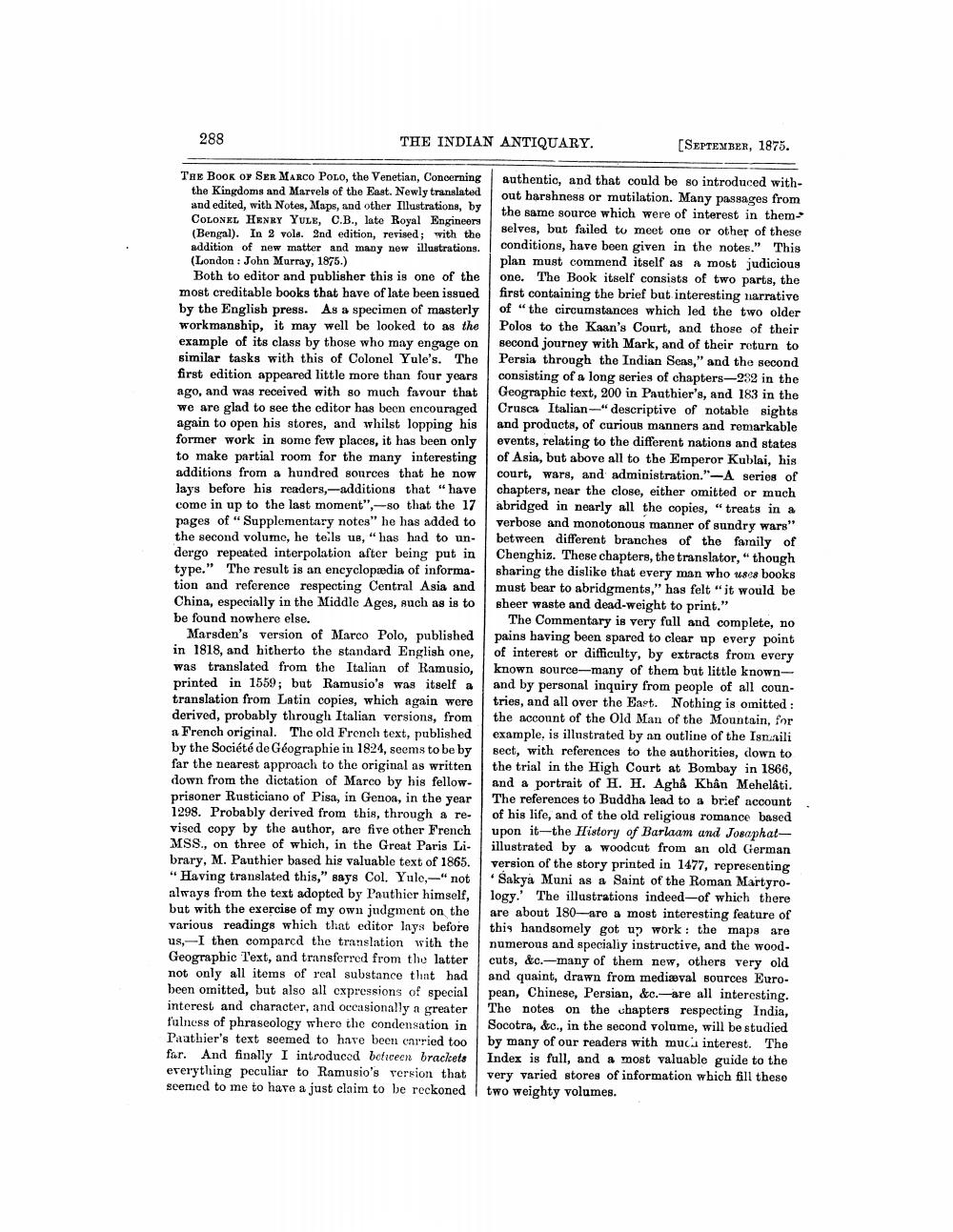________________
288
THE INDIAN ANTIQUARY.
[SEPTEMBER, 1875.
Tae Book OX SER MARCO Polo, the Venetian, Concerning
the Kingdoms and Marvels of the East. Newly translated and edited, with Notes, Maps, and other Illustrations, by COLONEL HENRY YULE, C.B., late Royal Engineers (Bengal). In 2 vols. 2nd edition, revised; with the addition of new matter and many new illustrations. (London: John Murray, 1875.)
Both to editor and publisher this is one of the most creditable books that have of late been issued by the English press. As a specimen of masterly workmanship, it may well be looked to as the example of its class by those who may engage on similar tasks with this of Colonel Yule's. The first edition appeared little more than four years ago, and was received with so much favour that we are glad to see the editor has been encouraged again to open his stores, and whilst lopping his former work in some few places, it has been only to make partial room for the many interesting additions from a hundred sources that he now lays before his readers, -additions that have come in up to the last moment", so that the 17 pages of " Supplementary notes" he has added to the second volume, he teils us," has had to undergo repeated interpolation after being put in type." The result is an encyclopædia of information and reference respecting Central Asia and China, especially in the Middle Ages, such as is to be found nowhere else.
Marsden's version of Marco Polo, published in 1818, and hitherto the standard English one, was translated from the Italian of Ramusio, printed in 1559; but Ramusio's was itself a translation from Latin copies, which again were derived, probably through Italian versions, from a French original. The old French text, published by the Société de Géographie in 1824, seems to be by far the nearest approach to the original as written down from the dictation of Marco by his fellowprisoner Rusticiano of Pisa, in Genoa, in the year 1298. Probably derived from this, through a revised copy by the author, are five other French MSS., on three of which, in the Great Paris Li- brary, M. Pauthier based hie valuable text of 1865. "Having translated this," says Col. Yulo -"not always from the text adopted by Pauthier himself, but with the exercise of my own judgment on the various readings which that editor lays before us.- I then compared the translation with the Geographic l'ext, and transferred from the latter not only all items of real substance thnt had been omitted, but also all expressions of special interest and character, and occasionally a greater t'ulness of phraseology where the condensation in Paathier's text seemed to have been onrried too far. And finally I introduced betrecn brackets everything peculiar to Ramusio's version that seemed to me to have a just claim to be reckoned
authentic, and that could be so introduced without harshness or mutilation. Many passages from the same source which were of interest in them selves, but failed to meet one or other of these conditions, have been given in the notes." This plan must commend itself as a most judicious one. The Book itself consists of two parts, the first containing the brief but interesting narrative of "the circumstances which led the two older Polos to the Kaan's Court, and those of their second journey with Mark, and of their return to Persia through the Indian Sens," and the second consisting of a long series of chapters-232 in the Geographic text, 200 in Pauthier's, and 183 in the Crusca Italian-"descriptive of notable sights and products, of curious manners and remarkable events, relating to the different nations and states of Asia, but above all to the Emperor Kublai, his court, wars, and administration."-A series of chapters, near the close, either omitted or much abridged in nearly all the copies, "treats in a verbose and monotonous manner of sundry wars" between different branches of the family of Chenghiz. These chapters, the translator, " though sharing the dislike that every man who 1808 books must bear to abridgments," has felt "it would be sheer waste and dead-weight to print."
The Commentary is very full and complete, no pains having been spared to clear up every point of interest or difficulty, by extracts from every known source-many of them but little knownand by personal inquiry from people of all countries, and all over the East. Nothing is omitted : the account of the Old Man of the Mountain, for example, is illustrated by an outline of the Ismaili sect, with references to the authorities, clown to the trial in the High Court at Bombay in 1866, and a portrait of H. H. Agha Khân Mehelâti. The references to Buddha lead to a brief account of his life, and of the old religious romance based upon it-the History of Barlaam and Josaphatillustrated by a woodcut from an old German version of the story printed in 1477, representing
Sakya Muni as a Saint of the Roman Martyrology.' The illustrations indeed-of which there are about 180-are a most interesting feature of this handsomely got up work: the maps are numerous and specialiy instructive, and the woodcuts, &c.-many of them new, others very old and quaint, drawn from medizval sources Euro. pean, Chinese, Persian, &c.-are all interesting. The notes on the chapters respecting India, Socotra, &c., in the second volume, will be studied by many of our readers with muci interest. The Index is full, and a most valuable guide to the very varied stores of information which fill these two weighty volumes.




